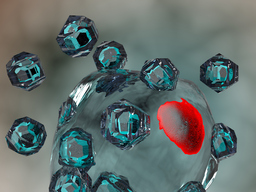Sting Agonist, Nanoformulations, and their uses For Treatment of Cancer, Viral Infection, and Bacterial Infection
TECHNOLOGY NUMBER: 2022-078

OVERVIEW
A new category of nanocarriers that provide better delivery of anti-cancer drugs- The development of new stimulator of interferon gene (STING) agonists
- Potential avenue of treatment for Clostridoides difficile and other infections
BACKGROUND
The stimulator of interferon genes (STING) transmembrane protein found in endoplasmic reticulum senses cytosolic double-stranded DNA and cyclic dinucleotides (CDNs). Activation of STING has shown great potential to enhance antitumor immunity through the induction of a variety of pro-inflammatory cytokines and chemokines. The STING pathway in immune cells can specifically lead to the production of type I interferons and the activation of anti-tumor CD8+ cytotoxic T cells. Still, the delivery of STING agonists requires optimization through proper drug delivery methods. The field of nanoparticles, or more specifically nanocarriers, as drug delivery methods has been growing for some time. These nanoparticles may be composed of albumin, liposomes, micelles, or lipids. Nanocarriers allow for increased stability of drugs in circulation, packaging of multiple drugs into individual particles for combination therapies, and modifications that increase cell and tissue specificity. Though a wide range of nanocarrier types based have been utilized, a need exists for further refinement of those delivery methods used in the treatment of cancer patients.
Innovation
Researchers have developed additional STING agonists that can be encapsulated into nanoparticles, and which are capable of also storing chemotherapeutic and immune regulatory drugs. The inventors aim to develop not only new STING agonists, but to develop both lipid-based and albumin-based nanocarriers that would deliver STING agonists along with currently available cancer and immune modulatory drugs for combination therapies. Initial studies in mice using an albumin-based nanovaccine carrying an immune stimulator and chemotherapeutic showed the ability to reduce tumor volume after 5 injections. The use of their protein-based nanoparticles shows increased targeting of the lymphatic system leading to better immune responses. And, when compared to other nanoparticles, those made of lipids or serum-derived proteins offer benefits in terms of cost and efficacy of drug delivery in the human body. Additionally, capitalizing on the activation of the STING pathway for the immune response during bacterial and viral infections, the inventors have developed an additional nanovaccine that is capable of enhancing the immune response through STING activation against Clostridoides difficile infections. All told, these advances may provide improvements in the efficacy of both chemotherapy and immunotherapy in the treatment of cancer as well as helping to control an array of infectious diseases.